Solar Energy in Argentina
Abstract
:1. Introduction
2. Energy in Argentina
3. Legal Framework for Renewables
3.1. Electricity Regulatory Framework
- Generation, transmission, and distribution are divided into three independent sectors, with specific rules. Distribution and transmission activities are considered a public service, while power generation is market driven, with specific sources which are nationally regulated.
- Electricity generators, distributors, transmission companies, large users and brokers are “agents” of the wholesale electricity market (WEM). The WEM is regulated in order to allow agents to trade electricity in spot transactions and in long-term power purchase agreements (PPAs). A private company, Compañía Administradora del Mercado Mayorista Eléctrico (CAMMESA), was appointed to administrate the WEM.
- The national electricity regulatory agency (ENRE, for its Spanish acronym) is responsible for supervising and controlling concessions related to the national power grid.
3.2. Heat Regulatory Framework
3.3. Legal Basis and Promotion of Large-Scale Photovoltaics
3.4. Legal Basis for Distributed Photovoltaics
3.5. Legal Basis for Solar Thermal Energy
4. Penetration of Solar Energy
4.1. Grid-Connected Photovoltaic Power Plants
Small Grid–Connected Generators
4.2. Off-Grid Photovoltaics
4.3. Analysis of the Local PV Value Chain
4.3.1. Local Manufacturing
4.4. De-Centralized Solar Thermal Energy
5. Research and Development
6. Discussion: Barriers to Argentina’s PV Development
7. Conclusions
Funding
Institutional Review Board Statement
Informed Consent Statement
Data Availability Statement
Acknowledgments
Conflicts of Interest
References
- Ernst & Young Global Limited Renewable Energy Country Attractiveness Index—Report 55. Available online: https://www.ey.com/en_gl/recai (accessed on 30 November 2021).
- Fernandez, R.; Saravia, L.; Scheuer, W. National Solar Program for Research and Development in Argentina. In Proceedings of the UNESCO/WMO, Symposia: Solar Energy, Geneva, Switzerland; 1977; pp. 263–271. [Google Scholar]
- CAMMESA. E-Renovables (Renewables Report). Available online: https://cammesaweb.cammesa.com/erenovables/ (accessed on 3 November 2021).
- International Energy Agency. IEA Energy Atlas. Available online: http://energyatlas.iea.org/#!/tellmap/-1118783123/0 (accessed on 3 November 2021).
- Argentine Secretary of Energy—Ministry of Economy of Argentina. Indicadores del Balance Energético Nacional (1960–2018); Official Reports; Ministry of Economy—Argentina: Buenos Aires, Argentina, 2019; Available online: https://www.argentina.gob.ar/economia/energia/planeamiento-energetico/infografias-de-escenarios-energeticos (accessed on 9 March 2022).
- CAMMESA. Annual Statistics Report 2005–2020. Available online: https://cammesaweb.cammesa.com/informe-anual/ (accessed on 18 October 2021).
- Di Sbroiavacca, N. Shale Oil and Shale Gas in Argentina. State of Situation and Prospective. In Oil and Natural Gas Economy in Argentina: The Case of Fracking; Bravo, V., Di Sbroiavacca, N., Eds.; The Latin American Studies Book Series; Springer International Publishing: Cham, Switzerland, 2021; pp. 281–300. ISBN 978-3-030-65520-4. [Google Scholar]
- Argentine Senate and Congress. Law 24.065: Régimen de la Energía Eléctrica. 1991. Available online: http://www.infoleg.gob.ar/ (accessed on 9 March 2022).
- Argentine Senate and Congress. Law 26.190: Régimen de Fomento Nacional para el Uso de Fuentes Renovables de Energía Destinada a la Producción de Energía Eléctrica. 2006. Available online: http://www.infoleg.gob.ar/ (accessed on 9 March 2022).
- Argentine Congress. Energía Argentina Sociedad Anónima—Su Creación. 2004. Available online: http://www.infoleg.gob.ar/ (accessed on 9 March 2022).
- Argentine Senate and Congress. Law 27.191: Modificaciones a La Ley 26.190, Régimen de Fomento Nacional para el Uso de Fuentes Renovables de Energía Destinada a la Producción de Energía Eléctrica. 2017. Available online: http://www.infoleg.gob.ar/ (accessed on 9 March 2022).
- Argentine Ministry of Energy and Mining. Resolution 136—E/2016: Energía Eléctrica de Fuentes Renovables. Convocatoria Abierta Nacional e Internacional. 2016. Available online: http://www.infoleg.gob.ar/ (accessed on 9 March 2022).
- Argentine Senate and Congress. Law 27.424: Régimen de Fomento a La Generación Distribuida de Energía Renovable Integrada a la Red Pública. 2017. Available online: http://www.infoleg.gob.ar/ (accessed on 9 March 2022).
- Argentine Ministry of Internal Affairs, Public Works and Housing. Progress Report: Actualización Exigencia Mínima de Componentes de Sustentabilidad. 2018. Available online: https://www.argentina.gob.ar/sites/default/files/actualizacion_exigencias_minimas_de_sustentabilidad_if-2018-51237809-apn-dnasyfmi.pdf (accessed on 23 November 2021).
- Compañía Administradora del Mercado Mayorista Eléctrico (CAMMESA). Annex: ANEXO Informe MATER Enero. 2022. Available online: https://cammesaweb.cammesa.com/mater/ (accessed on 17 February 2022).
- Solargis, S.R.O. Solar Resource Map/Global Horizontal Radiation/Argentina. Available online: https://globalsolaratlas.info/download/argentina (accessed on 3 November 2021).
- Koop, F.; Pike, L. China Builds Latin America’s Largest Solar Plant. Available online: https://chinadialogue.net/en/energy/11117-china-builds-latin-america-s-largest-solar-plant/ (accessed on 14 December 2021).
- Matias, M. Cauchari Está a la Espera de Firmar el PPA con CAMMESA para Ampliar el Parque Solar a 500 MW—Energía Estratégica. Available online: https://www.energiaestrategica.com/cauchari-esta-a-la-espera-de-firmar-el-ppa-con-cammesa-para-ampliar-el-parque-solar-a-500-mw/ (accessed on 14 December 2021).
- Argentine Secretary of Energy—Ministry of Economy. Progress Report: Implementación de la Ley 27.424. 2021. Available online: https://www.argentina.gob.ar/economia/energia/generacion-distribuida/que-es-la-generacion-distribuida/reportes-de-avance-implementacion-de-la-ley-27424 (accessed on 13 December 2021).
- Schaube, P.; Ortiz, W.; Recalde, M. Status and Future Dynamics of Decentralised Renewable Energy Niche Building Processes in Argentina. Energy Res. Soc. Sci. 2018, 35, 57–67. [Google Scholar] [CrossRef] [Green Version]
- Alazraki, R.; Haselip, J. Assessing the Uptake of Small-Scale Photovoltaic Electricity Production in Argentina: The PERMER Project. J. Clean. Prod. 2007, 15, 131–142. [Google Scholar] [CrossRef]
- Schmukler, M. Is Local Adequacy of Technology a Pathway towards Social Inclusion? The Challenges of Rural Electrification in Argentina. Innov. Dev. 2020, 10, 263–278. [Google Scholar] [CrossRef]
- Fernandez-Fuentes, M.H.; Eras-Almeida, A.A.; Egido-Aguilera, M.A. Characterization of Technological Innovations in Photovoltaic Rural Electrification, Based on the Experiences of Bolivia, Peru, and Argentina: Third Generation Solar Home Systems. Sustainability 2021, 13, 3032. [Google Scholar] [CrossRef]
- Haley, U.C.V.; Schuler, D.A. Government Policy and Firm Strategy in the Solar Photovoltaic Industry. Calif. Manag. Rev. 2011, 54, 17–38. [Google Scholar] [CrossRef]
- Gomel, D.; Rogge, K.S. Mere Deployment of Renewables or Industry Formation, Too? Exploring the Role of Advocacy Communities for the Argentinean Energy Policy Mix. Environ. Innov. Soc. Transit. 2020, 36, 345–371. [Google Scholar] [CrossRef]
- Castelao Caruana, M.E. Renewable Energy in Argentina as an Energy and Industrial Policy Strategy. Problemas del Desarrollo 2019, 50, 131–156. [Google Scholar] [CrossRef] [Green Version]
- Singh, N. El Listado de Fabricas Líderes que Apostaron al Desarrollo de la Cadena de Valor Para el Rubro Eólico y Solar en Argentina. Available online: https://www.energiaestrategica.com/fabricas-rubro-eolico-y-solar-en-argentina/ (accessed on 28 October 2021).
- Fabri, S.A. Ingeniería, Construcciones y Montajes Industriales. Available online: https://fabrisa.com.ar/ (accessed on 25 November 2021).
- SOLARTEC. Available online: https://www.solartec.com.ar/en/aboutus.html (accessed on 13 December 2021).
- EPSE (Energía Provincial Sociedad del Estado). Fábrica Integrada De Lingotes De Silicio Solar, Obleas y Celdas Cristalinas Y Paneles Solares Fotovoltaicos 71 MW. Available online: https://www.epse.com.ar/web/proyecto/fabrica-integrada-de-lingotes-de-silicio-solar-obleas-y-celdas-cristalinas-y-paneles-solares-fotovoltaicos-71-mw/1 (accessed on 25 November 2021).
- Medinilla, M. EPSE Avanza en la Fábrica de Paneles Solares y en el Desarrollo de las Renovables en San Juan. Available online: https://www.energiaestrategica.com/epse-avanza-en-la-fabrica-de-paneles-solares-y-en-el-desarrollo-de-las-renovables-en-san-juan/ (accessed on 25 November 2021).
- EPSE (Energía Provincial Sociedad del Estado). Proyectos Fotovoltaicos en San Juan. Available online: https://www.epse.com.ar/web/proyecto/proyectos-fotovoltaicos-en-san-juan/27 (accessed on 25 November 2021).
- EPSE (Energía Provincial Sociedad del Estado). EPSE Realizará El Proyecto Para El Parque Solar Neuquén, de 50 MWp. Available online: https://www.epse.com.ar/web/novedad/epserealizaraelproyectoparaelparquesolarneuquende50mwp/380 (accessed on 25 November 2021).
- Instituto Argentino de Normalización y Certificación (Argentine Quality Standards Institute). Norma IRAM 210001-1/-2. 1985. Available online: https://www.iram.org.ar (accessed on 25 November 2021).
- Bril-Mascarenhas, T.; Post, A.E. Policy Traps: Consumer Subsidies in Post-Crisis Argentina. St. Comp. Int. Dev. 2015, 50, 98–120. [Google Scholar] [CrossRef] [Green Version]
- Giuliano, F.; Lugo, M.A.; Masut, A.; Puig, J. Distributional Effects of Reducing Energy Subsidies: Evidence from Recent Policy Reform in Argentina. Energy Econ. 2020, 92, 104980. [Google Scholar] [CrossRef]
- Gonzalo, G.; Gonzalo, R. Development through solar energy. A project in NW Argentina. Entwicklung mit Sonnenenergie. Ein Projekt in NW-Argentinien. Sonnenenergie 1990, 15, 5. [Google Scholar]
- Lawand, T.A.; Ayoub, J.; Alward, R.; Brunet, E. Renewable Energy Activities in Rural Argentina. Renew. Energy 1994, 5, 1334–1341. [Google Scholar] [CrossRef]
- Herrera, C.B. Subsidios En El Servicio Público de Distribución de Gas; Research Report; Univ. Nacional de Cuyo: Mendoza, Argentina, 2016. [Google Scholar]
- ENARGAS Informe Especial: TARIFA SOCIAL. Available online: https://www.enargas.gob.ar/ (accessed on 30 November 2021).
- INTI Censo Solar Térmico (Solar Thermal Census). Available online: www.inti.gob.ar (accessed on 30 November 2021).
- Grossi Gallegos, H.; Lopardo, R.; Atienza, G. Solar Radiation Network in Argentina. In Proceedings of the International Solar Energy Society, Brighton, UK, 1 January 1982; Volume 3, pp. 2456–2460. [Google Scholar]
- Gallegos, H.G.; Lopardo, R. Spatial Variability of the Global Solar Radiation Obtained by the Solarimetric Network in the Argentine Pampa Humeda. Sol. Energy 1988, 40, 397–404. [Google Scholar] [CrossRef]
- Albizzati, E.D.; Rossetti, G.H.; Alfano, O.M. Measurements and Predictions of Solar Radiation Incident on Horizontal Surfaces at Santa Fe, Argentina (31°39′ S, 60°43′ W). Renew. Energy 1997, 11, 469–478. [Google Scholar] [CrossRef]
- Piacentini, R.D.; Cede, A.; Bárcena, H. Extreme Solar Total and UV Irradiances Due to Cloud Effect Measured near the Summer Solstice at the High-Altitude Desertic Plateau Puna of Atacama (Argentina). J. Atmos. Sol.-Terr. Phys. 2003, 65, 727–731. [Google Scholar] [CrossRef]
- Arboit, M.; Diblasi, A.; Fernández Llano, J.C.; De Rosa, C. Assessing the Solar Potential of Low-Density Urban Environments in Andean Cities with Desert Climates: The Case of the City of Mendoza, in Argentina. Renew. Energy 2008, 33, 1733–1748. [Google Scholar] [CrossRef]
- Almorox, J.; Bocco, M.; Willington, E. Estimation of Daily Global Solar Radiation from Measured Temperatures at Cañada de Luque, Córdoba, Argentina. Renew. Energy 2013, 60, 382–387. [Google Scholar] [CrossRef] [Green Version]
- Sarmiento, N.; Belmonte, S.; Dellicompagni, P.; Franco, J.; Escalante, K.; Sarmiento, J. A Solar Irradiation GIS as Decision Support Tool for the Province of Salta, Argentina. Renew. Energy 2019, 132, 68–80. [Google Scholar] [CrossRef] [Green Version]
- Frulla, L.A.; Gagliardini, D.A.; Gallegos, H.G.; Lopardo, R.; Tarpley, J.D. Incident Solar Radiation on Argentina from the Geostationary Satellite GOES: Comparison with Ground Measurements. Sol. Energy 1988, 41, 61–69. [Google Scholar] [CrossRef]
- Podestá, G.P.; Núñez, L.; Villanueva, C.A.; Skansi, M.A. Estimating Daily Solar Radiation in the Argentine Pampas. Agric. For. Meteorol. 2004, 123, 41–53. [Google Scholar] [CrossRef]
- Righini, R.; Grossi Gallegos, H.; Raichijk, C. Approach to Drawing New Global Solar Irradiation Contour Maps for Argentina. Renew. Energy 2005, 30, 1241–1255. [Google Scholar] [CrossRef]
- Grossi Gallegos, H.; Righini, R.; Raichijk, C. Analysis of Alternatives for the Assessment of the Solar Resource in Argentina. In Proceedings of the World Renewable Energy Congress IX, Florence, Italy, 19–25 August 2006. [Google Scholar]
- Saravia, L.; Echazú, R.; Cadena, C.; Condorí, M.; Cabanillas, C.; Iriarte, A.; Bistoni, S. Greenhouse Solar Heating in the Argentinian Northwest. Renew. Energy 1997, 11, 119–128. [Google Scholar] [CrossRef]
- Iriarte, A.; Bistoni, S.; Saravia, L. Heating systems of special solar-greenhouses; Calefaccion solar de invernaderos especiales. In Proceedings of the ISES Millenium Solar Forum 2000, Mexico City, Mexico, 1 July 2000; pp. 473–477. [Google Scholar]
- Franco, J.; Saravia, L.R.; Esteban, S. Multistage Still. In Proceedings of the 24th National Passive Solar Conference, Portland, OR, USA, 1 July 1999. [Google Scholar]
- Franco, J.; Cadena, C.; Saravia, L. Multiple Use Communal Solar Cookers. Sol. Energy 2004, 77, 217–223. [Google Scholar] [CrossRef]
- Condorí, M.; Saravia, L. The Performance of Forced Convection Greenhouse Driers. Renew. Energy 1998, 13, 453–469. [Google Scholar] [CrossRef]
- Condorí, M.; Echazú, R.; Saravia, L. Solar Drying of Sweet Pepper and Garlic Using the Tunnel Greenhouse Drier. Renew. Energy 2001, 22, 447–460. [Google Scholar] [CrossRef]
- Condorí, M.; Saravia, L. Analytical Model for the Performance of the Tunnel-Type Greenhouse Drier. Renew. Energy 2003, 28, 467–485. [Google Scholar] [CrossRef]
- Altobelli, F.; Condorí, M.; Duran, G.; Martinez, C. Solar Dryer Efficiency Considering the Total Drying Potential. Application of This Potential as a Resource Indicator in North-Western Argentina. Sol. Energy 2014, 105, 742–759. [Google Scholar] [CrossRef]
- Duran, G.; Condorí, M.; Altobelli, F. Simulation of a Passive Solar Dryer to Charqui Production Using Temperature and Pressure Networks. Sol. Energy 2015, 119, 310–318. [Google Scholar] [CrossRef]
- Condorí, M.; Duran, G.; Echazú, R.; Altobelli, F. Semi-Industrial Drying of Vegetables Using an Array of Large Solar Air Collectors. Energy Sustain. Dev. 2017, 37, 1–9. [Google Scholar] [CrossRef]
- Franco, J.; Saravia, L.; Javi, V.; Caso, R.; Fernandez, C. Pasteurization of Goat Milk Using a Low Cost Solar Concentrator. Sol. Energy 2008, 82, 1088–1094. [Google Scholar] [CrossRef]
- Lesino, G.; Saravia, L.; Galli, D. Industrial Production of Sodium Sulfate Using Solar Ponds. Sol. Energy 1990, 45, 215–219. [Google Scholar] [CrossRef]
- Lesino, G.; Saravia, L. Solar Ponds in Hydrometallurgy and Salt Production. Sol. Energy 1991, 46, 377–382. [Google Scholar] [CrossRef]
- Dellicompagni, P.; Franco, J. Potential Uses of a Prototype Linear Fresnel Concentration System. Renew. Energy 2019, 136, 1044–1054. [Google Scholar] [CrossRef]
- Gulino, S.; Rodas, J.; Gregor, R. Linear Fresnel Concentrator: A Review of Its Implementation in South American Countries. In Proceedings of the 2020 IEEE PES Transmission Distribution Conference and Exhibition—Latin America (T D LA), Montevideo, Uruguay, 28 September–2 October 2020; pp. 1–6. [Google Scholar]
- Dellicompagni, P.; Hongn, M.; Saravia, L.; Altamirano, M.; Placeo, C.; Gea, M.; Hoyos, D.; Bárcena, H.; Suligoy, H.; Fernández, C.; et al. Concentrador solar termico fresnel lineal de San Carlos, Salta. Primeros ensayos de operación y funcionamiento (172m2). Avances Energías Renovables Medio Ambiente-AVERMA 2021, 20, 1–12. [Google Scholar]
- Solar Villages Light up the Andes. Available online: https://www.ecoandina.org/blog/8-solar-villages-light-up-the-andes (accessed on 30 November 2021).
- Instituto de Vivienda y Urbanismo de Jujuy—IVUJ. Proceso de Fabricación Del Termotanque Solar—Jujuy Solar. 2016; Available online: https://www.ivuj.gob.ar/index.php/2016-05-16-11-40-48/251-con-el-sol-ahorramos-una-excelente-opcion-para-el-hogar (see also https://www.youtube.com/watch?v=Ka3YBTiRLW4); (accessed on 9 March 2022). [Google Scholar]
- Nicolás, R.O.; Durán, J.C. Theoretical Maximum Concentration Factors for Solar Concentrators. J. Opt. Soc. Am. A JOSAA 1984, 1, 1110–1113. [Google Scholar] [CrossRef]
- Durán, J.C.; Nicolás, R.O. Development and Applications of a Two-Dimensional Optical Analysis of Non-Perfect Cylindrical Concentrators. Sol. Energy 1985, 34, 257–269. [Google Scholar] [CrossRef]
- Nicolás, R.O.; Durán, J.C. Generalization of the Two-Dimensional Optical Analysis of Cylindrical Concentrators. Sol. Energy 1980, 25, 21–31. [Google Scholar] [CrossRef]
- Durán, J.C.; Venier, G.; Weht, R. Optimization of the Junction Depth and Doping of Solar Cell Emitters. Sol. Cells 1991, 31, 497–503. [Google Scholar] [CrossRef]
- Vaccaro, P.O.; Meyer, G.; Saura, J. Effects of CdCl2 on the Growth of CdTe on CdS Films for Solar Cells by Isothermal Close-Spaced Vapour Transport. J. phys. D Appl. phys. 1991, 24, 1886–1889. [Google Scholar] [CrossRef]
- Meyer, G. Transient Current Measurements for the Determination of the Fermi Level in Semiconductors. Meas. Sci. Technol. 1993, 4, 1489–1492. [Google Scholar] [CrossRef]
- Meyer, G.; Saura, J. Undoped and Indium-Doped CdS Films Prepared by Chemical Vapour Deposition. J Mater Sci 1993, 28, 5335–5339. [Google Scholar] [CrossRef]
- Alurralde, M.; Tamasi, M.J.L.; Bruno, C.J.; Martίnez Bogado, M.G.; Plá, J.; Fernández Vázquez, J.; Durán, J.; Schuff, J.; Burlon, A.A.; Stoliar, P.; et al. Experimental and Theoretical Radiation Damage Studies on Crystalline Silicon Solar Cells. Sol. Energy Mater. Sol. Cells 2004, 82, 531–542. [Google Scholar] [CrossRef]
- Bolzi, C.G.; Bruno, C.J.; Duran, J.C.; Godfrin, E.M.; Martinez Bogado, M.G.; Merino, L.M.; Pla, J.C.; Tamasi, M.J.L.; Barrera, M. SAC-A Satellite: First Experiment of Argentine Solar Cells in Space. In Proceedings of the Conference Record of the Twenty-Eighth IEEE Photovoltaic Specialists Conference—2000 (Cat. No.00CH37036), Anchorage, AK, USA, 15–22 September 2000; pp. 1344–1347. [Google Scholar]
- Bolzi, C.G.; Bruno, C.J.; Durán, J.C.; Godfrin, E.M.; Bogado, M.G.M.; Merino, L.M.; Plá, J.C.; Tamasi, M.J.L.; Barrera, M. First Experiment of Argentine Solar Cells in Space: Modules Fabrication, Characterisation, and Telemetry Data Analysis from SAC-A Satellite. Sol. Energy Mater. Sol. Cells 2002, 73, 269–280. [Google Scholar] [CrossRef]
- Alurralde, M.; Barrera, M.; Bolzi, C.G.; Bruno, C.J.; Cabot, P.; Carella, E.; Di Santo, J.; Durán, J.C.; Fernández Slezak, D.; Fernández Vázquez, J.; et al. Development of Solar Arrays for Argentine Satellite Missions. Aerosp. Sci. Technol. 2013, 26, 38–52. [Google Scholar] [CrossRef]
- EMCORE. Announces Closing of Sale of Its Space Photovoltaics Business to an Affiliate of Veritas Capital for $150 Million|EMCORE. Available online: https://investor.emcore.com/news-releases/news-release-details/emcore-announces-closing-sale-its-space-photovoltaics-business (accessed on 4 October 2021).
- Ibarra, M.L.; Garcia, J.A.; Dato, A.; Yaccuzzi, E.; Prario, I.; Filevich, A.; Barrera, M.; Alurralde, M.E.D.R.A. The Argentine Facility to Simulate Radiation Damage in Space. Radiat. Phys. Chem. 2019, 154, 79–84. [Google Scholar] [CrossRef]
- Rubinelli, F.A.; Jiménez, R.; Rath, J.K.; Schropp, R.E.I. Using Computer Modeling Analysis in Single Junction A-SiGe:H p–i–n Solar Cells. J. Appl. Phys. 2002, 91, 2409–2416. [Google Scholar] [CrossRef]
- Zambrano, R.J.; Rubinelli, F.A.; Arnoldbik, W.M.; Rath, J.K.; Schropp, R.E.I. Computer-Aided Band Gap Engineering and Experimental Verification of Amorphous Silicon–Germanium Solar Cells. Sol. Energy Mater. Sol. Cells 2004, 81, 73–86. [Google Scholar] [CrossRef]
- Strengers, J.J.H.; Rubinelli, F.A.; Rath, J.K.; Schropp, R.E.I. A Combined Experimental and Computer Simulation Study of HWCVD Nip Microcrystalline Silicon Solar Cells. Thin Solid Films 2006, 501, 291–294. [Google Scholar] [CrossRef]
- Taretto, K.; Rau, U.; Werner, J.H. Numerical Simulation of Grain Boundary Effects in Cu(In,Ga)Se2 Thin-Film Solar Cells. Thin Solid Films 2005, 480–481, 8–12. [Google Scholar] [CrossRef]
- Taretto, K.; Rau, U. Numerical Simulation of Carrier Collection and Recombination at Grain Boundaries in Cu (In, Ga) Se2 Solar Cells. J. Appl. Phys. 2008, 103, 094523. [Google Scholar] [CrossRef]
- Kirchartz, T.; Taretto, K.; Rau, U. Efficiency Limits of Organic Bulk Heterojunction Solar Cells. J. Phys. Chem. C 2009, 113, 17958–17966. [Google Scholar] [CrossRef]
- Kirchartz, T.; Pieters, B.E.; Taretto, K.; Rau, U. Electro-Optical Modeling of Bulk Heterojunction Solar Cells. J. Appl. Phys. 2008, 104, 094513–094519. [Google Scholar] [CrossRef] [Green Version]
- Kirchartz, T.; Pieters, B.E.; Taretto, K.; Rau, U. Mobility Dependent Efficiencies of Organic Bulk Heterojunction Solar Cells: Surface Recombination and Charge Transfer State Distribution. Phys. Rev. B 2009, 80, 035334. [Google Scholar] [CrossRef] [Green Version]
- Schmidt, J.A.; Longeaud, C. Density of States Determination from Steady-State Photocarrier Grating Measurements. Appl. Phys. Lett. 2004, 85, 4412–4414. [Google Scholar] [CrossRef] [Green Version]
- Schmidt, J.A.; Budini, N.; Ventosinos, F.; Longeaud, C. Theoretical Analysis and Experimental Results on the Modulated Photocarrier Grating Technique. Phys. Status Solidi (A) 2010, 207, 556–560. [Google Scholar] [CrossRef]
- Kind, R.; Van Swaaij, R.A.C.M.M.; Rubinelli, F.A.; Solntsev, S.; Zeman, M. Thermal Ideality Factor of Hydrogenated Amorphous Silicon Pin Solar Cells. J. Appl. Phys. 2011, 110, 104512. [Google Scholar] [CrossRef] [Green Version]
- Troviano, M.; Taretto, K. Analysis of Internal Quantum Efficiency in Double-Graded Bandgap Solar Cells Including Sub-Bandgap Absorption. Sol. Energy Mater. Sol. Cells 2011, 95, 821–828. [Google Scholar] [CrossRef]
- Troviano, M.; Taretto, K. Temperature-Dependent Quantum Efficiency Analysis of Graded-Gap Cu (In, Ga) Se2 Solar Cells. Sol. Energy Mater. Sol. Cells 2011, 95, 3081–3086. [Google Scholar]
- Cossutta, H.; Taretto, K.; Troviano, M. Low-Cost System for Micrometer-Resolution Solar Cell Characterization by Light Beam-Induced Current Mapping. Meas. Sci. Technol. 2014, 25, 105801. [Google Scholar] [CrossRef]
- Budini, N.; Rinaldi, P.A.; Schmidt, J.A.; Arce, R.D.; Buitrago, R.H. Influence of Microstructure and Hydrogen Concentration on Amorphous Silicon Crystallization. Thin Solid Films 2010, 518, 5349–5354. [Google Scholar] [CrossRef]
- Schmidt, J.A.; Budini, N.; Rinaldi, P.; Arce, R.D.; Buitrago, R.H. Large-Grained Oriented Polycrystalline Silicon Thin Films Prepared by Nickel-Silicide-Induced Crystallization. J. Cryst. Growth 2008, 311, 54–58. [Google Scholar] [CrossRef]
- Jimenez Zambrano, R.; Rubinelli, F.A.; Rath, J.K.; Schropp, R.E.I. Improvement in the Spectral Response at Long Wavelength of A-SiGe:H Solar Cells by Exponential Band Gap Design of the i-Layer. J. Non-Cryst. Solids 2002, 299–302, 1131–1135. [Google Scholar] [CrossRef]
- Rath, J.K.; Rubinelli, F.A.; Schropp, R.E.I. Effect of Oxide Treatment at the Microcrystalline Tunnel Junction of A-Si:H/a-Si:H Tandem Cells. J. Non-Cryst. Solids 2000, 266–269, 1129–1133. [Google Scholar] [CrossRef]
- Rubinelli, F.A.; Rath, J.K.; Schropp, R.E.I. Microcrystalline N-i-p Tunnel Junction in a-Si:H/a-Si:H Tandem Cells. J. Appl. Phys. 2001, 89, 4010–4018. [Google Scholar] [CrossRef] [Green Version]
- Valdés, M.H.; Berruet, M.; Goossens, A.; Vázquez, M. Spray Deposition of CuInS2 on Electrodeposited ZnO for Low-Cost Solar Cells. Surf. Coat. Technol. 2010, 204, 3995–4000. [Google Scholar] [CrossRef]
- Di Iorio, Y.; Berruet, M.; Schreiner, W.; Vázquez, M. Characterization of CuInS2 Thin Films Prepared by One-Step Electrodeposition. J. Appl. Electrochem. 2014, 44, 1279–1287. [Google Scholar] [CrossRef]
- Berruet, M.; Di Iorio, Y.; Troviano, M.; Vázquez, M. ZnO and Copper Indium Chalcogenide Heterojunctions Prepared by Inexpensive Methods. Mater. Chem. Phys. 2014, 148, 1071–1077. [Google Scholar] [CrossRef]
- Taretto, K.; Soldera, M.; Koffman-Frischknecht, A. Material Parameters and Perspectives for Efficiency Improvements in Perovskite Solar Cells Obtained by Analytical Modeling. IEEE J. Photovolt. 2017, 7, 206–213. [Google Scholar] [CrossRef]
- Soldera, M.; Taretto, K. Combining Thickness Reduction and Light Trapping for Potential Efficiency Improvements in Perovskite Solar Cells. Physica Status Solidi (A) 2018, 215, 1700906. [Google Scholar] [CrossRef]
- Soldera, M.; Frischknecht, A.K.; Taretto, K. Optical and Electrical Optimization of All-Perovskite Pin Type Junction Tandem Solar Cells. J. Phys. D Appl. Phys. 2020, 53, 315104. [Google Scholar] [CrossRef]
- Suarez, B.; Gonzalez-Pedro, V.; Ripolles, T.S.; Sanchez, R.S.; Otero, L.; Mora-Sero, I. Recombination Study of Combined Halides (Cl, Br, I) Perovskite Solar Cells. J. Phys. Chem. Lett. 2014, 5, 1628–1635. [Google Scholar] [CrossRef]
- Frischknecht, A.K.; Yaccuzzi, E.; Plá, J.; Perez, M.D. Anomalous Photocurrent Response of Hybrid TiO2:P3HT Solar Cells under Different Incident Light Wavelengths. Sol. Energy Mater. Sol. Cells 2016, 157, 907–912. [Google Scholar] [CrossRef]
- Iorio, Y.D.; Berruet, M.; Gau, D.L.; Spera, E.L.; Pereyra, C.J.; Marotti, R.E.; Vázquez, M. Efficiency Improvements in Solution-Based CuInS2 Solar Cells Incorporating a Cl-Doped ZnO Nanopillars Array. Physica Status Solidi (A) 2017, 214, 1700191. [Google Scholar] [CrossRef]
- Berruet, M.; Iorio, Y.D.; Pereyra, C.J.; Marotti, R.E.; Vázquez, M. Highly-Efficient Superstrate Cu2ZnSnS4 Solar Cell Fabricated Low-Cost Methods. Phys. Status Solidi (RRL)–Rapid Res. Lett. 2017, 11, 1700144. [Google Scholar] [CrossRef]
- Suárez, M.B.; Aranda, C.; Macor, L.; Durantini, J.; Heredia, D.A.; Durantini, E.N.; Otero, L.; Guerrero, A.; Gervaldo, M. Perovskite Solar Cells with Versatile Electropolymerized Fullerene as Electron Extraction Layer. Electrochim. Acta 2018, 292, 697–706. [Google Scholar] [CrossRef]
- Koffman-Frischknecht, A.; Gonzalez, F.; Plá, J.; Violi, I.; Soler-Illia, G.J.A.A.; Perez, M.D. Impact of the Titania Nanostructure on Charge Transport and Its Application in Hybrid Solar Cells. Appl. Nanosci. 2018, 8, 665–673. [Google Scholar] [CrossRef]
- Pereyra, C.J.; Di Iorio, Y.; Berruet, M.; Vazquez, M.; Marotti, R.E. Influence of a Nanostructured ZnO Layer on the Carrier Recombination and Dynamics in Chalcopyrite Solar Cells. J. Mater. Sci. 2020, 55, 9703–9711. [Google Scholar] [CrossRef]
- Gómez Andrade, V.A.; Herrera Martínez, W.O.; Redondo, F.; Correa Guerrero, N.B.; Roncaroli, F.; Perez, M.D. Fe and Ti Metal-Organic Frameworks: Towards Tailored Materials for Photovoltaic Applications. Appl. Mater. Today 2021, 22, 100915. [Google Scholar] [CrossRef]
- Solis, C.; Durantini, J.E.; Macor, L.; Heredia, D.A.; Gonzalez Lopez, E.J.; Durantini, E.N.; Mangione, M.I.; Rappich, J.; Dittrich, T.; Otero, L.; et al. Electrochemical Formation of Photoactive Organic Heterojunctions. Porphyrin-C60 Polymeric Photoelectrochemical Cells. Electrochim. Acta 2021, 365, 137333. [Google Scholar] [CrossRef]
- Córdoba, M.; Herrera, W.; Koffman-Frischknecht, A.; Correa, N.; Perez, M.D.; Taretto, K. Electroluminescence Transients and Correlation with Steady-State Solar Output in Solution-Prepared CH3NH3PbI3 Perovskite Solar Cells Using Different Contact Materials. J. Phys. D Appl. Phys. 2020, 53, 115501. [Google Scholar] [CrossRef]
- Ventosinos, F.; Koffman-Frischknecht, A.; Herrera, W.; Senno, M.; Caram, J.; Perez, M.D.; Schmidt, J.A. Estimation of Carrier Mobilities and Recombination Lifetime in Halide Perovskites Films Using the Moving Grating Technique. J. Phys. D Appl. Phys. 2020, 53, 415107. [Google Scholar] [CrossRef]
- Perez, M.D.; González, F.D.; Correa Guerrero, N.B.; Viva, F.A. Carrier Conduction Mechanisms of Mesoporous Titania Thin Films Assessed by Impedance Spectroscopy. Microporous Mesoporous Mater. 2019, 283, 31–38. [Google Scholar] [CrossRef]
- Australian Photovoltaic Institute • Market Analyses. Available online: https://pv-map.apvi.org.au (accessed on 26 January 2022).
- Energia, S.I.-C.N. Electricidad—Comisión Nacional de Energía. Available online: https://www.cne.cl/normativas/electrica/consulta-publica/electricidad/ (accessed on 4 February 2022).
- Agostini, C.A.; Nasirov, S.; Silva, C. Solar PV Planning Toward Sustainable Development in Chile: Challenges and Recommendations. J. Environ. Dev. 2016, 25, 25–46. [Google Scholar] [CrossRef]
- Roy, D. Argentina: A South American Power Struggles for Stability. Available online: https://www.cfr.org/backgrounder/argentina-south-american-power-struggles-stability (accessed on 7 February 2022).
- Spiller, P.T.; Stein, E.H.; Tommasi, M.; Scartascini, C.; Melo, M.A.; Mueller, B.; Pereira, C.; Aninat, C.; Londregan, J.; Navia, P.; et al. Policymaking in Latin America: How Politics Shapes Policies; Inter-American Development Bank: Washington, DC, USA, 2008; ISBN 978-1-59782-061-5. [Google Scholar]
- Cable.co.uk. Worldwide Electricity Pricing—Energy Cost per KWh in 230 Countries. Available online: https://www.cable.co.uk/energy/worldwide-pricing/ (accessed on 3 February 2022).
- Argentine Secretary of Energy—Ministry of Economy of Argentina. Reactivación de Obras de Transporte Eléctrico. Available online: https://www.argentina.gob.ar/economia/energia/energia-electrica/linea-extra-alta-tension-rio-diamante (accessed on 9 March 2022).
- Argentine Ministry of Economy—Energy Secretary. Resolution 1036/2021: Lineamientos para un Plan de Transición Energética al 2030. 2021. Available online: http://www.infoleg.gob.ar/ (accessed on 9 March 2022).
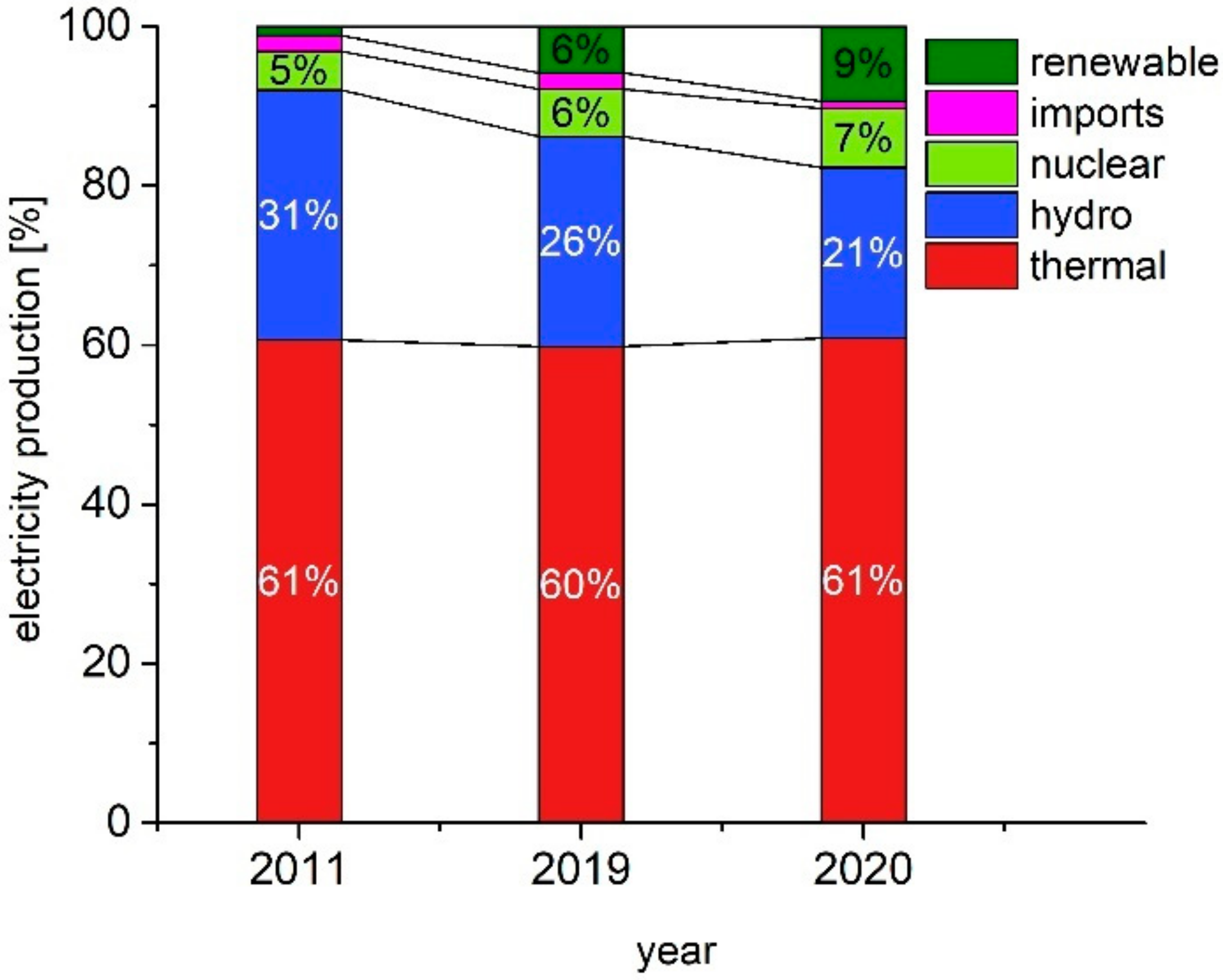
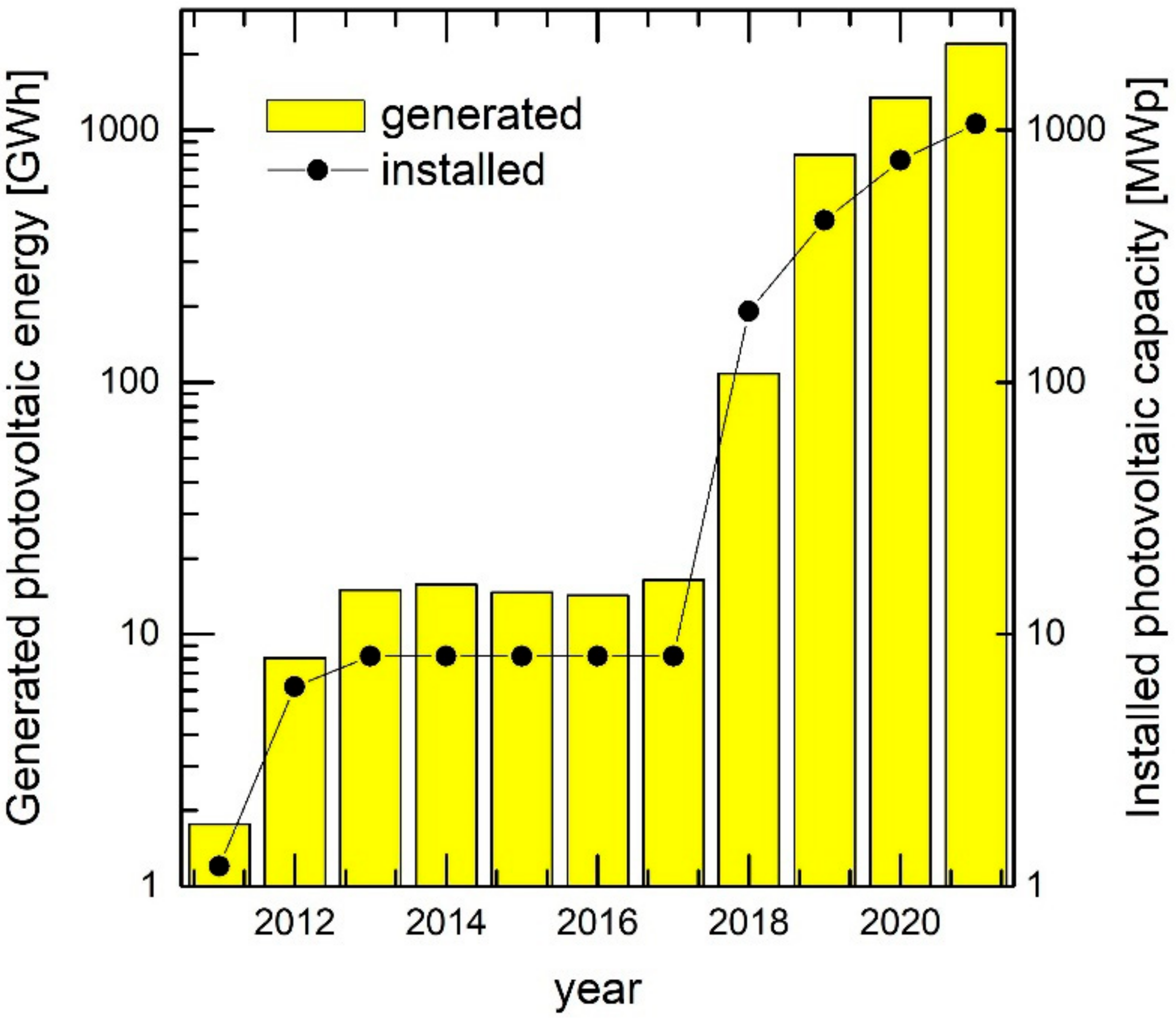
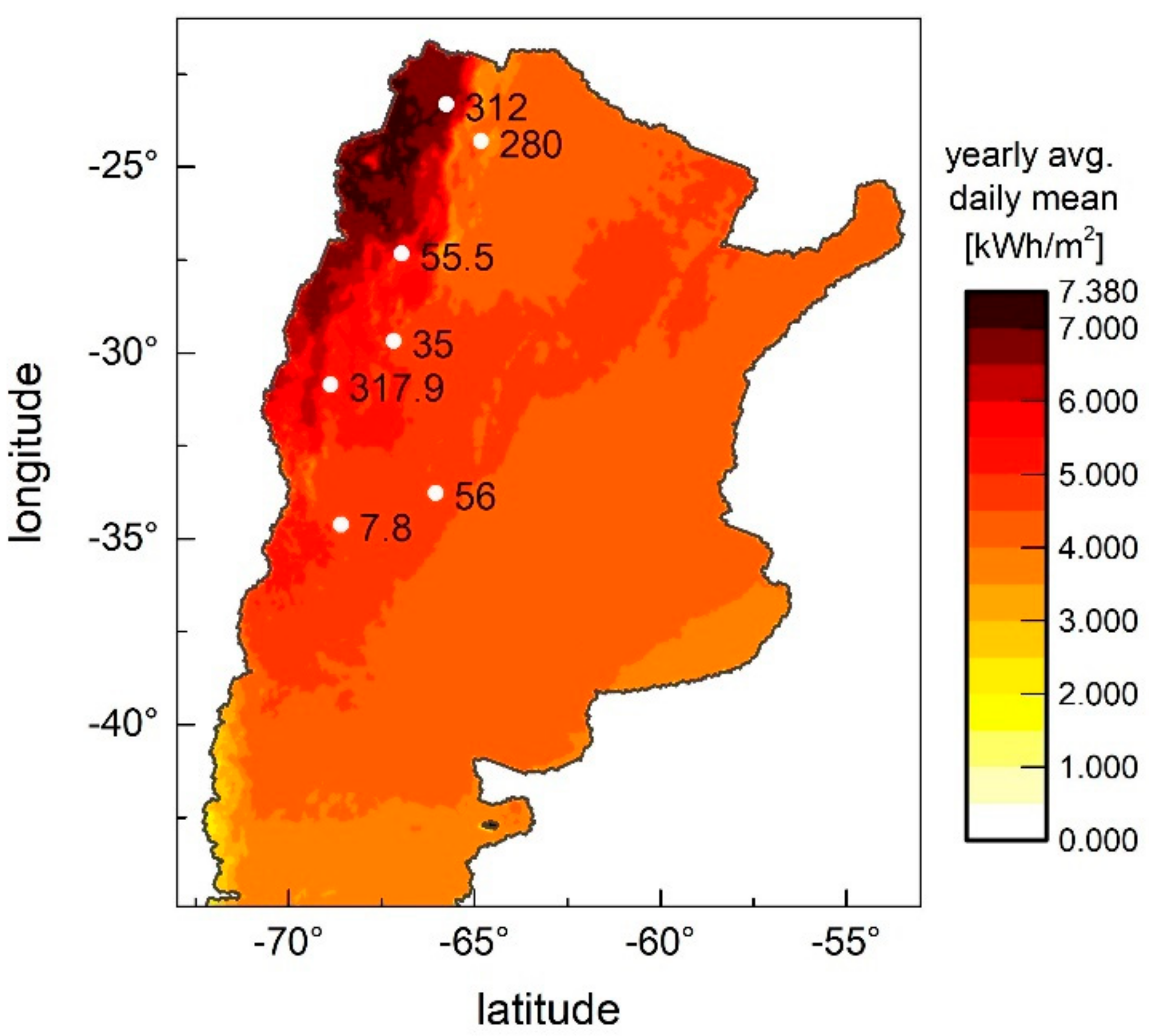
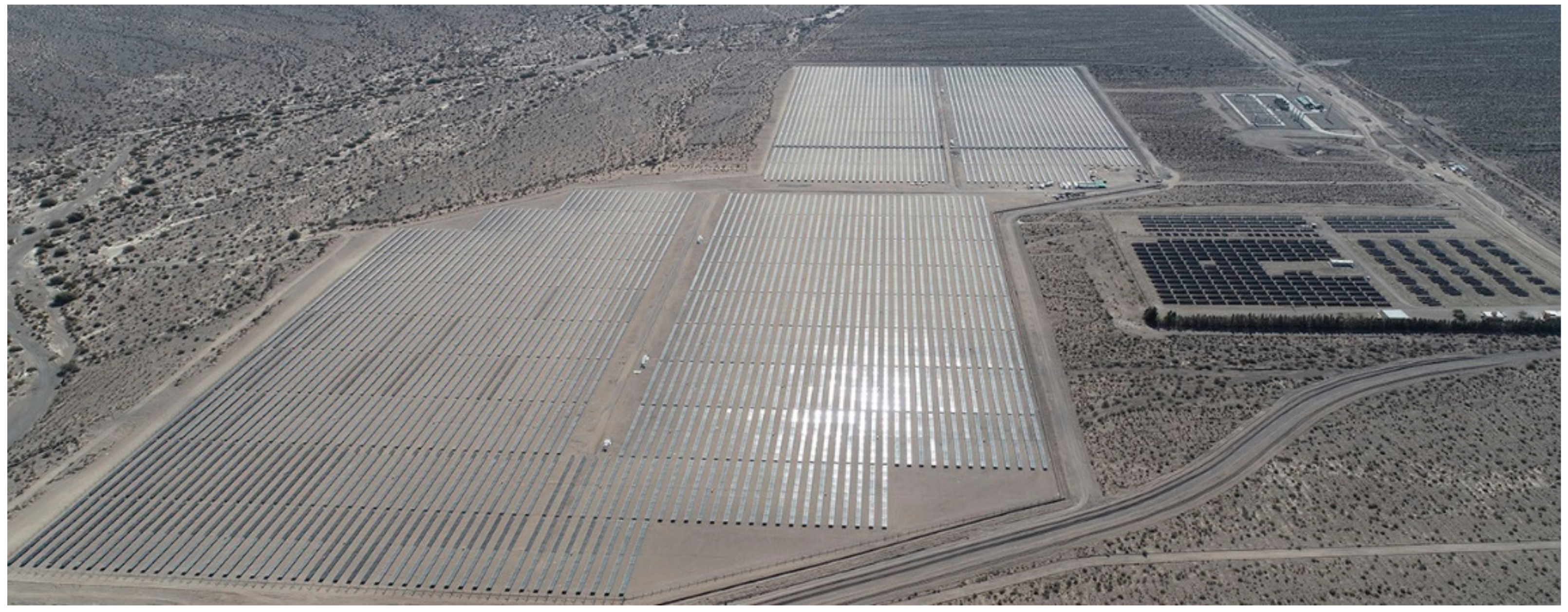

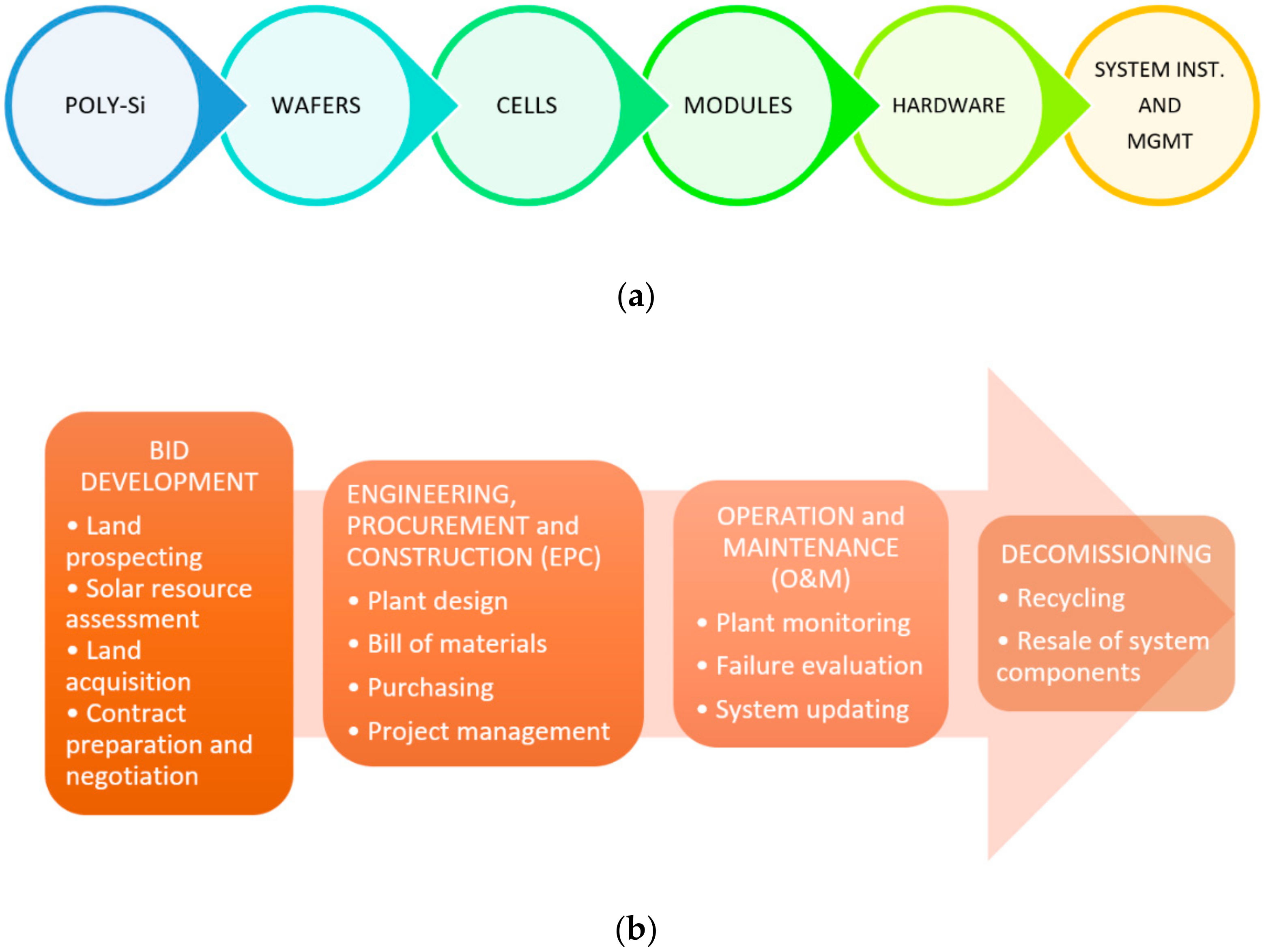
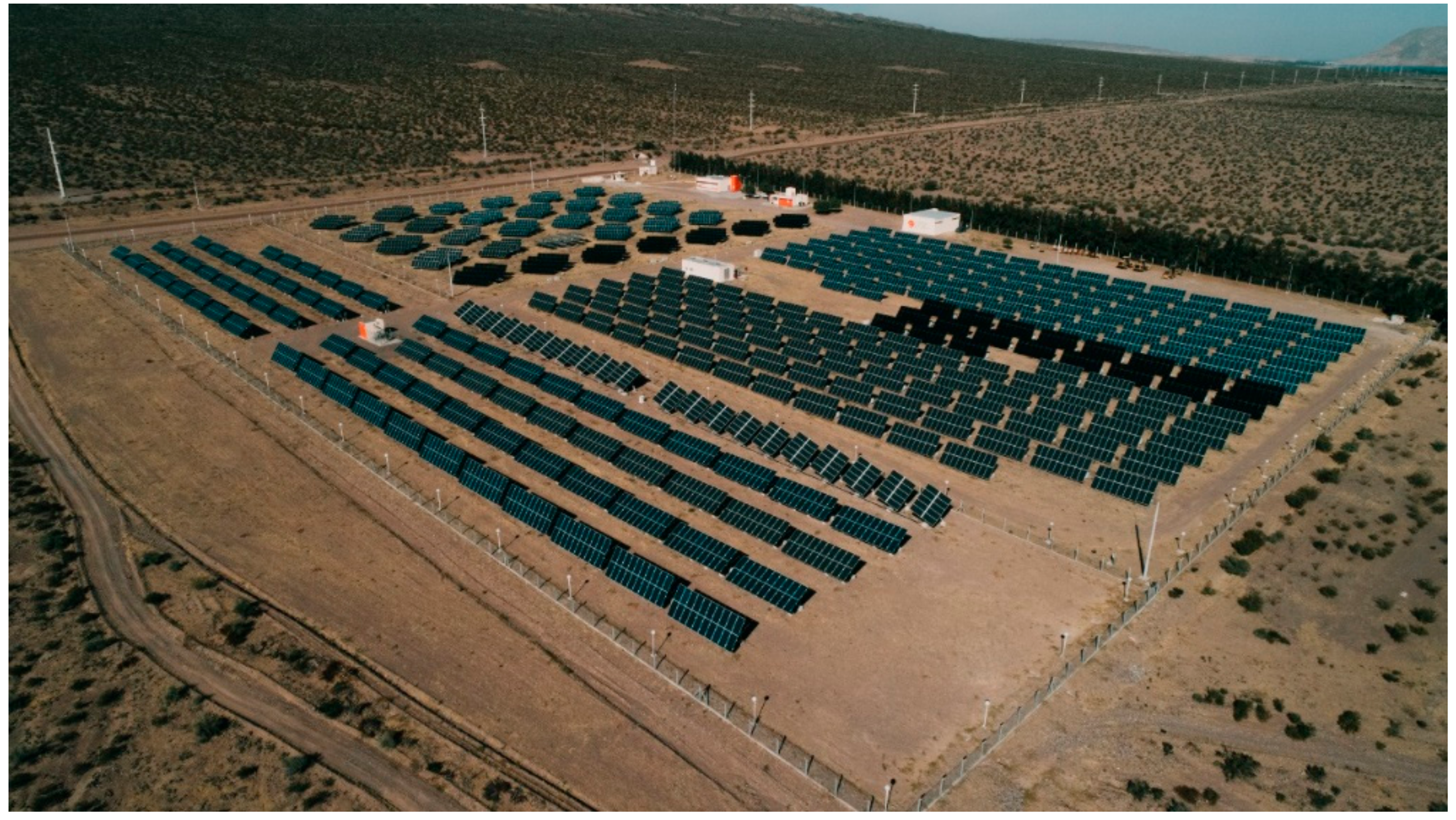
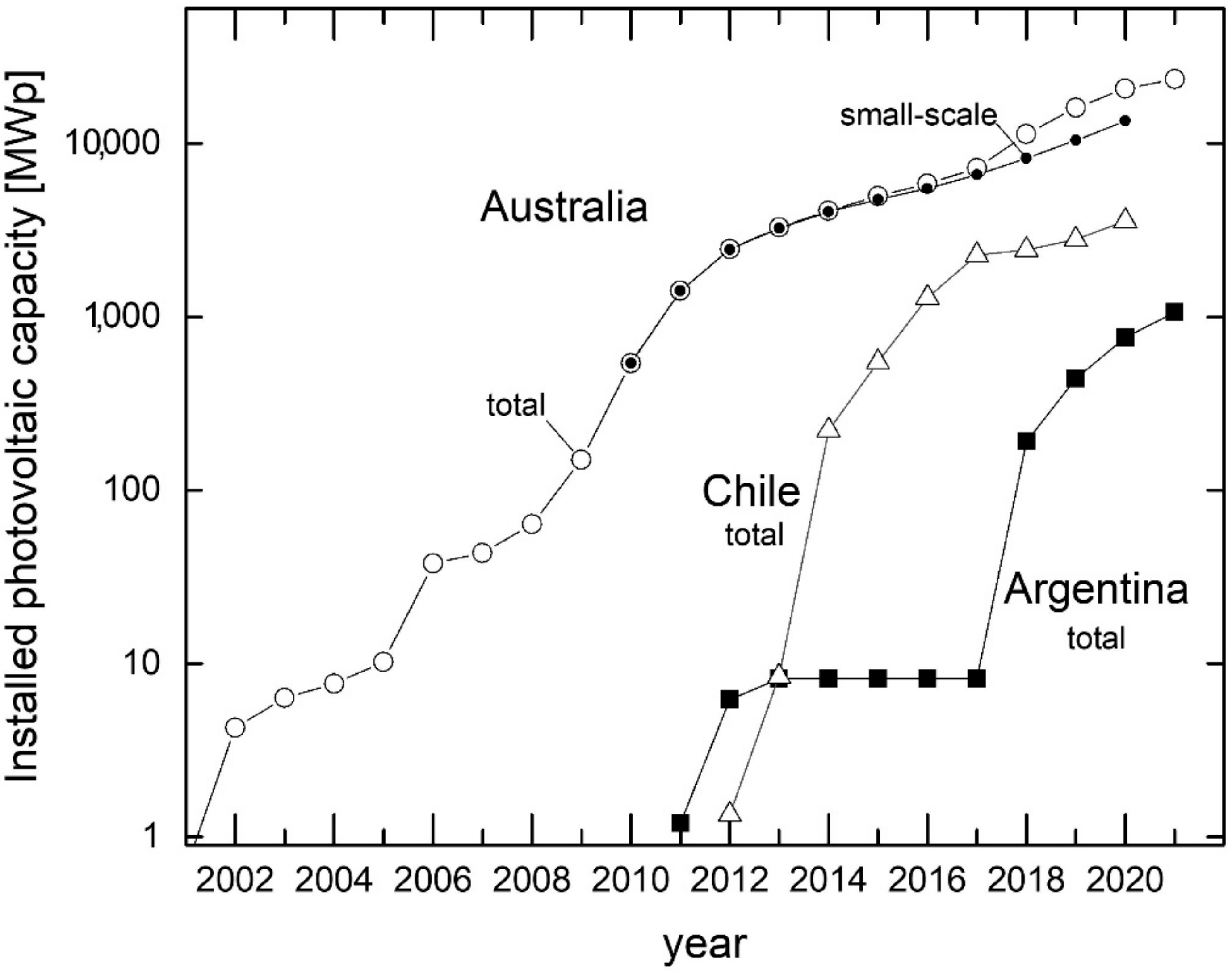
Publisher’s Note: MDPI stays neutral with regard to jurisdictional claims in published maps and institutional affiliations. |
© 2022 by the authors. Licensee MDPI, Basel, Switzerland. This article is an open access article distributed under the terms and conditions of the Creative Commons Attribution (CC BY) license (https://creativecommons.org/licenses/by/4.0/).
Share and Cite
Bragagnolo, J.A.; Taretto, K.; Navntoft, C. Solar Energy in Argentina. Solar 2022, 2, 120-140. https://doi.org/10.3390/solar2020008
Bragagnolo JA, Taretto K, Navntoft C. Solar Energy in Argentina. Solar. 2022; 2(2):120-140. https://doi.org/10.3390/solar2020008
Chicago/Turabian StyleBragagnolo, Julio A., Kurt Taretto, and Christian Navntoft. 2022. "Solar Energy in Argentina" Solar 2, no. 2: 120-140. https://doi.org/10.3390/solar2020008
APA StyleBragagnolo, J. A., Taretto, K., & Navntoft, C. (2022). Solar Energy in Argentina. Solar, 2(2), 120-140. https://doi.org/10.3390/solar2020008






